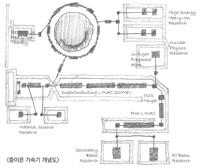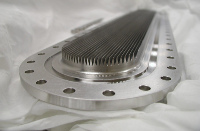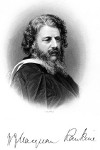Korea to build new science and business city

Conceptual design for Korean rare isotope accelerator
|
Since the leadership of its President Lee Myung-bak, Korea has placed high value on science and technology. On 13 January, the government officially signed a contract for a big project to build an international science and business belt that includes the establishment of a new institute, the Asian Basic Science Institute (ABSI), and the construction of a Rare Isotope Accelerator.
Read more...
-- Rika Takahashi |
|
 |
From SLAC Today: Groovy Beam Pipe Update

This insert, manufactured by SLAC and the company EMEGA, was placed inside the KEK-B accelerator beam pipe to trap stray electrons with its triangular grooves.
Photo: Mauro Pivi. |
Something unwanted lurks within accelerator beam pipes around the world: stray electrons. This haze of electrons interacts with positron and proton beams, often causing distortion. Previous tests showed that an insert designed by SLAC researchers works well to capture stray electrons in an environment with no magnetic field. Now, recent tests carried out at the Japanese accelerator facility KEK confirm that a new insert can reduce this electron cloud effect in a magnetic field.
Read more...
-- Kelen Tuttle |
 |
|
|
 |
From Interactions
27 January 2009
New grant will help UK remain at cutting edge of particle physics
The work of UK physicists in the quest to unravel the secrets of the fundamental building blocks of our Universe has just (27th January 2009) received a boost with a 10 year, £16.7M grant from the Science and Technology Facilities Council (STFC) to Durham University’s Institute for Particle Physics Phenomenology (IPPP)—a research centre dedicated to the application of theory to high energy particle physics experiments.
Read more... |
|
From CERN Courier
27 January 2009
Accelerators shine as experts gather in Genoa
EPAC returned to Italy for the last meeting in this European series, which is to merge into an annual international event. It revealed the increasing strength and breadth of research in particle accelerators, which seems destined for a bright future.
Read more... |
|
From CERN Courier
27 January 2009
DESY awards two building contracts for European XFEL
DESY has commissioned two consortia of renowned building contractors to construct the underground buildings (tunnels, shafts and halls) for the 3.4 km long X-ray laser facility, European XFEL.
Read more... |
|
From New York Times
26 January 2009
Essay: Elevating Science, Elevating Democracy
...Those values, among others, are honesty, doubt, respect for evidence, openness, accountability and tolerance and indeed hunger for opposing points of view.
Read more... |
|
From Fermilab Today
23 January 2009
Energy Secretary Steven Chu looks to labs for DOE’s future
The Department of Energy’s new leader, Energy Secretary Steven Chu, quite literally wants the organization to help save the world.
Read more... |
|
|
 |
 |
|
|
 |
ILC power
Today's issue features a Director's Corner by Ewan Paterson, Member of the GDE Executive Committee.

Rankine (Scots Physicist, 1820-72) was an early leader in the science of thermodynamics where much of the motivation was energy efficiency and the target technology was the steam engine. |
I have many times been in the situation where I took an interested non-expert on a tour of SLAC National Accelerator Laboratory and explained how it relates to a future project, the International Linear Collider. I would often say that in several ways it is similar but ten times longer. This particularly gets a lot of attention while standing in the 3-kilometre-long klystron gallery where one is never sure that you can really see the end! This immediately leads to the question "where could you build something that is 30 kilometres long?" The fact that it would be mostly in underground tunnels and could be built almost anywhere in the world is usually a satisfactory answer.
Read more...
-- Ewan Paterson
Director's Corner Archive |
 |
|
|
 |
|
arXiv preprints
0901.4183
LiC Detector Toy - Tracking detector optimization with fast simulation and its application to the ILD design
0901.4151
Study of Beam Profile Measurement at Interaction Point in International Linear Collider
0901.4132
Status of the CALICE DAQ system
0901.4020
Implementation and application of kinematic vertex fitting in the software environment of ILD
0901.3598
Analysis of ZHH in the 4-jet mode
0901.3429
Development of Pair Monitor
0901.3427
Development of Readout ASIC for FPCCD Vertex Detector
0901.3159
A powerful tool for measuring Higgs associated Lepton Flavour Violation
|
|

